► Hot-hatch clash: Golf R vs Focus RS
► Both have 4wd and turbo fours
► But there can only be one winner…
Camouflage, secret test locations, PR denials in the face of overwhelming evidence… Mostly, car manufacturers conceal new-model testing, so it’s unusual that Ford commissioned a documentary to chronicle Focus RS development. There’s marketing puff, but proper fly-on-the-wall moments too: a car breaking, engines failing, deadlines missed, all of it on YouTube.
Towards the end of the series of shorts, chief technical officer Raj Nair drives the RS. ‘That’s Normal mode?’ he asks. ‘That’s terrible!’ His parting shot is a You’re Fired-style ‘it’s not signed off yet, guys.’
Brave, but it underlines the effort Ford has put into making the third-generation Focus RS the best it can be. Of course, it ends happily when the crack team don’t sleep for weeks and give the RS a final polish, and maybe they took the really bad stuff out. But now no amount of editing can help them, as the first RSs are released into the wild from Valencia airport.
We can’t emphasise how crucial this new hot Ford is. The first global RS – China! USA! 40 other places! – is also the first all-wheel-drive RS model since the 1992 Escort RS Cosworth. For two generations of Focus RS, Ford told us that all-wheel drive added weight and cost and killed fun. Frisky front drivers were where it was at. We’re going to experience what’s shifted that mind set while pitching the Focus against the Volkswagen Golf R.
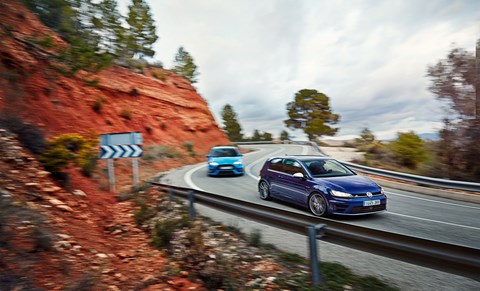
CAR’s favourite hot hatch, the Golf R has a price and spec that puts it on a collision course with the RS: four-cylinder turbo, all-wheel drive, circa £30k sticker. But how’s this for different philosophies: in the same way a prefect may find 0.4% ginger beer awfully naughty, VW gets very excited that you can turn off the R’s stability control completely; Ford, meanwhile, brings us Drift mode, which transforms the RS into a tyre-frying hooligan. Ford offers optional bucket seats and stickier tyres, VW a dual-clutch transmission that’s just the job on the daily grind.
Climb into the RS and you’ll find ho-hum Focus basics enlivened with RS fairy dust: your thumbs slide over tactile blue stitching on the tautly contoured steering rim, slot instinctively into the quarter-to-three position and squish into perforated leather. There are alloy pedals, a noticeably truncated gear lever and, most importantly, two designs of sports seats.
Inside the Ford Focus RS
Ford’s standard chairs are so high I can’t decide if I should be wearing a bib or a lifeguard vest, but they look great and hug you like you’re being gripped in a boxing glove. Plumper pilots complained of the constriction, preferring the optional and racier-looking – but still perfectly habitable – buckets. Bizarrely, these sportier sports seats perch higher still and swallow big-boned patrons more easily; I’d spend the cash on the forged 19-inch alloys and Michelin Cup 2 tyres like 80% of buyers. We’re on the stock Pilot Super Sports now, trying the Cup 2s on track tomorrow.
On the quick dash down the autoroute from the airport, the RS quickly raises our already high expectations. The previous RS got a gurgly five-cylinder turbo mill, this time it’s a Mustang-derived four-cylinder Ecoboost. But not only has it been strengthened and tuned, Ford’s worked on the goose bumps too.
A symposer pipes induction tunes into the cabin, plus there’s reduced sound deadening and a little extra fuel thrown around; it equates to a guttural,rev-me-nuts-off exhaust note and mini explosions when you change gear. Thing is, you’d know the RS means business even with the RS’s volume muted: an eye-opening wodge of low-down torque pulls you through gaps in traffic and swooshes you down slip roads; even if you’re not trying, this thing feels rapid, and Ford claims just five seconds from 31-62mph in fourth gear.
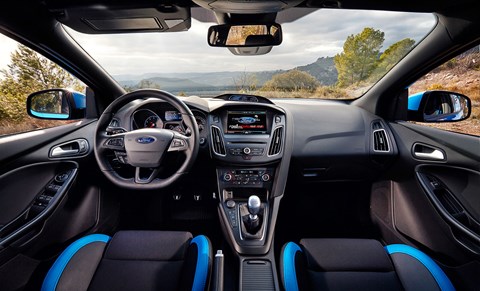
There is a call-and-response nature to the delivery, a disconnect between the sound of you pressing the throttle and the turbo waking up, but it’s slight and, really, throttle response is very good. Switch to Sport and the sense of connection deepens. The electrically assisted steering has nuance, lightly vibrating with road-surface information, reacting quickly and naturally and with none of the sponginess off-centre that Nair criticised in the Ford film; the gear shift is slick and easy – slicker than a manual Golf R – and while the throw could be shorter still, it’s plenty punchy enough.
It’s no big surprise that the RS is not going to iron out bumps like the Golf R, though: on these smooth roads there’s already an underlying agitation to the Normal mode suspension, a little vertical choppiness; you have to conclude it’ll be much more pronounced on UK tarmac.
Ford Focus RS vs VW Golf R: the stat-off
But I’m convinced the Golf is going to have its work cut out as we rush to meet it, because the Focus romps the Top Trumps war. At 2.3 litres it’s got 300cc on the Golf, plus the crucial matter of 345bhp and 325lb ft, victories of 49bhp and 45lb ft respectively. That’s not to mention the 22lb ft Brucey overboost bonus that works for 18sec; in normal driving you’ll have overboost whenever you want.
Will anyone notice that the Golf is 30kg lighter? That the dual-clutcher we’re testing delivers 4mpg and 16g/km better efficiency? Not when eyeballs are drawn to the Ford’s incredible 4.7sec claimed 0-62mph sprint (Golf: 4.9sec), and 165mph top whack (the Golf’s limited to 155mph).
Both acceleration times are thanks to the assured traction of four driven wheels – aided by launch control on the RS – but the way they put that power down is fundamentally different: the Golf takes power to the rear with a traditional Haldex system, albeit housing a fifth-generation coupling that’s impressed us before.
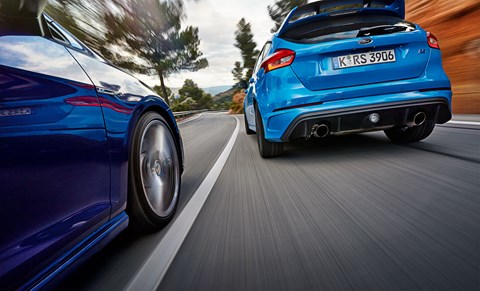
The Focus uses a system essentially similar to the Range Rover Evoque’s and supplied by GKN Driveline; it uses twin clutch packs located either side of a rear-drive unit and shuffles torque front-to-rear and side-to-side across the rear axle. But here it’s dealing with 110bhp more than the Evoque has ever thrown at it, so it’s significantly re-engineered.
When we arrive at our location, the Golf is all understated aggression save for its one-per-cylinder exhaust tips, the Focus grabbing attention with its big rear wing, shouty diffuser and a front end that appears to be gorging on Everlasting Gobstoppers. It’s literally cramming as much air as possible into the front end, says RS boss Tyrone Johnson later, adding that the diffuser reduces drag and the spoiler eliminates lift. No gimmicks here.
The VW Golf R cabin: quality all the way
Inside, the Golf doesn’t move the game on significantly beyond the GTI, but it looks more cohesive than the Focus in that typically understated Germanic way, exudes higher quality, and the infotainment is easier to fathom. Peripheral to the driving experience maybe, but a great hot hatch does everything well.
I head straight out in the Golf, and immediately it impresses. Yes, the seats could go lower, but they’re positively subterranean compared with the Focus highchairs, and while an R pilot doesn’t have quite the support of his RS rival, the seats are fine, daily-driver comfortable and give the restrained cabin a lift.
From our photographic vantage point, the N330 near Los Pedrones plunges down hill, zigging and zagging through mountain terrain that rarely allows the steering to straighten for more than a second or so. It tough work for the Golf’s sliding-caliper brakes, and really highlights weight transfer if you push a little too hard.
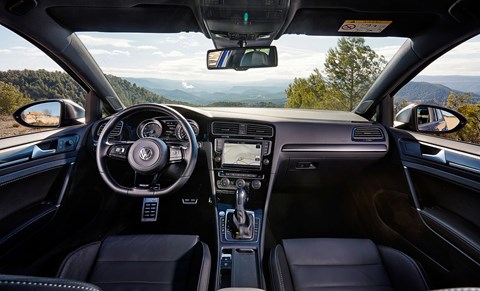
Yet the Golf quickly finds a rhythm. Its steering is light, fast and precise, and the variable ratio means you never need move your hands from quarter-to-three; the brake pedal feel is good, stopping power strong, the EA888 turbo quick to muster its ponies and fling you down the road. The Golf R is a car you can jump in and quickly pick apart an unfamiliar and challenging road.
Like the Focus, there’s a little lag to the power delivery, but again it’s slight, throttle response is impressively keen, and the hit of easily accessible torque gives the performance a flexibility that’d send front tyres scrabbling on front drivers, but never does on the R. Not everyone likes the artificial engine sounds playing in the cabin, but they give the Golf a pulsing, more guttural backing track than its lower-powered – but still EA888-motivated – GTI stablemate.
The road test bit
Our car gets optional adaptive dampers – standard with Ford – and it’s immediately obvious that we can side-step Comfort mode; there’s such cushiness and body roll compared with the RS that the balance feels tilted too far towards, well, comfort. Body roll persists in Normal mode, but it’s well contained and feels natural, giving you a sense of the tyres’ approaching limits while the steering simultaneously weights up and tremors a little in your hands.
Our DSG Golf lacks the manual’s sense of involvement, but makes you quicker on tortuous roads; select the wrong gear before a corner and you just tap a paddleshifter where the RS driver would be crossed-up, groping for a stick and trying to re-engage the clutch.
‘An epic stretch of road: hairpins and faster swoops’
As the topography levels out, I take the CV439 west of Cofrentes. It’s an epic stretch of road, with tricky flicks of direction, low-speed climbs out of hairpins and faster swoops that challenge traction and body control and reveal just how well a car can cling to its line. It’s the perfect place to assess how differently the two cars’ all-wheel-drive systems operate.
Not so long ago, all-wheel-drive Golfs lagged a little when the front tyres ran out of talent and delegated to the rears; we’re talking milliseconds, but it felt so tardy that the traction crisis sometimes ended before the rear wheels chipped in.
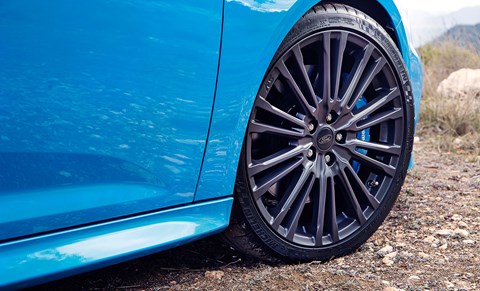
The faster-acting Haldex coupling means the lag is history, but the Golf continues to feel like a front-drive hatch with the scragginess dialled out; it just hooks up and fires down the next straight, but the sensation of being pulled by your collar remains. Wolfsburg’s ESP-based torque vectoring by braking acts on top of this, subtly tweaking the inside front brake when necessary and tugging it towards the apex; it kills understeer and adds adjustability, a kind of ski-slalom energy as the Golf’s backside jigs left and right through bends. Go into a corner off-power and then exaggerate your steering and instead of understeering, the Golf simply claws extra grip out of the surface and describes a tighter arc. It’s a lot of fun.
The Golf is 49bhp down on the Focus and feels it, but it’s so optimally balanced that it’s quite a thing to hustle cross-country. Factor in that classless design, the usability, the higher perceived quality, the super-quick DSG… the Focus driving dynamics will need to blow it out of the water to neutralise all that.
Performance, kick in the back
Well, take cover Wolfsburg. Immediately the RS feels stronger, ripping through to peak revs where you wish the Golf had that 50bhp surplus and another 500rpm breathing space for a final flourish.
What’s really striking is how the Ford transfers power to the road. We remember the wild tug of the Mk1’s Quaife ATB diff, the clever torque-steer-quelling Revo Knuckle suspension of the Mk2, but this is just something else; the all-wheel-drive set-up actually makes the RS feel rear-drive. So you not only get the sense of power being transferred rearwards when necessary, it seems to be there constantly, like you’re steering with the throttle. The genius is you’ve also got an all-wheel-drive security blanket, but one that actually increases driving engagement because you can attack corners harder and faster.
At first your brain tells you to modulate the throttle, to go easy for a second because the nose is going to rise and you’re adding steering and understeer is inevitable. You still get that feeling in the Golf. The RS can’t defy physics, you can’t just pin the throttle at any speed and expect zero understeer, but there are plenty of moments where you’re at part-throttle in the Golf and the RS chassis can take everything the more powerful Ecoboost lump can throw at it. And when it runs out of smarts, the four-piston brakes have deeper reserves than a Saudi oil well. The Golf’s stoppers do a good job, but they’re out-classed here.

Ford has dropped the Focus ST’s variable-ratio steering system for the RS, and you can feel why. I try the same off-power trick as I did in the Golf, barrelling into a corner and adding a bung of steering, and the RS’s trick torque vectoring makes it feel significantly shorter and more wieldy than if you took the same corner more sensibly; it’s a similar feeling to the Golf in some ways, but it’s almost shockingly agile, and I suspect that adding steering that quickens the more you turn it would actually make the RS feel unstable and unpredictable.
What we lose in steering trickery, we more than gainin driving modes. Just like the about-face with all-wheel-drive, Ford always told us that one driving mode was all you need. Now we get Normal, Sport, Race and Drift.
On the road you’re best served with Normal or Sport, the latter reducing steering assistance, while upping throttle response and introducing those engaging little backfires. The dampers – already firm – remain unchanged, but you can stiffen them by 40% by prodding the end of the indicator stalk to select Race. Not one for the road. Sport’s extra throttle response adds to the thrill, the noise is more engaging, but the steering becomes heavier and self-centres like a boomerang with separation anxiety, even if it does blend into the background when your blood’s up and your eyes are on stalks scanning apex after apex. This is where the Focus RS rules, covering ground so quickly that the Golf can’t summon an answer.
The Ford Focus RS and the art of drift
Not that it’s all about sure-footed speed. When I first heard about Drift mode, I thought I’d be the hero and drive with it engaged all the time. Now my brain can’t pre-emptively understand what’s going to happen. I just press a button and all of a sudden a car with Superglue traction puts its football shirt over its head and does massive skids?
Drift mode switches the drive modes to Normal suspension (so you get more oversteer-promoting body roll) and steering (so slides are easier to catch), and tweaks the power delivery more aggressively rearwards. Ford only partially disables the stability control initially, but press it again and it’s just you and a good lawyer. On the road, the RS doesn’t feel like a drift monster, and you have to work it hard to wind on even a quarter turn of oppo. It just feels a little less stable, less well sorted, and actually there’s more fun to be had from making the RS cover ground as quickly as talent can carry you.
I tried Drift mode on track, and you have to be pretty aggressive to get it properly smoking; it’s a lot of fun and a neat little trick to demonstrate the rear bias, but if you’re used to rear-drive cars, it feels artificial; I just wanted to disconnect the front driveshafts altogether.
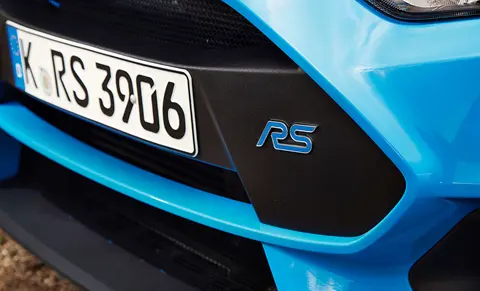
That track was Valencia, with its challenging flat-out lefts, quick flicks and big stops into double-apex bends. We weren’t allowed to bring the Golf R to a track Ford had hired for the launch, but I did take my long-termer to play at Rockingham recently, and the differences are pronounced. Mostly, when you take a road car on track, there’s a level of adjustment, the space egging you on to carry excess speed into corners. It means you must adapt to avoid understeer and clumsy weight transfer that you won’t experience on the road. This is true of the Golf.
The Focus RS doesn’t really do that. Ford says it’s designed to excite the expert and flatter the novice, and it really does. It’s got such grip and balance that you basically point the RS where you want to go and it does it. The rear will slide when you over-cook it, the front will understeer, but the limits are very, very high, and for the most part it feels like you’re thinking it through a lap, not adjusting to how it wants to be driven.
The beefy brakes and solid body control pay dividends here – as do the optional Cup 2 tyres – but I’m not totally convinced I prefer Race mode on track; sometimes the rear end felt so firm it would hop about when you turned at the end of a heavy braking zone, where softer Sport offered more fluidity.
Verdict
The Golf is a different kettle of fish. It’s still fun, still adjustable, but you have to baby it around a lap like Williams F1 engineer Rob Smedley talking Felipe Massa through a GP. It’s more traditional in that when you push hard, you can feel the weight over the front end and the tyres slipping into understeer and the body roll scrappily dragging you off line; you spend your time caressing the Golf into corners and easing off the brakes, like taking your weight off an infant’s bed without waking them.
The Focus is a little heavier, longer, wider and taller than the Golf, and yet it’s the wieldier, more intuitive machine to pedal quickly. For some, the RS image will be enough to keep them out of its driver’s seat, and the Golf remains a better all-rounder, while still being incredibly satisfying to drive.
But if you want the best drivers’ hot-hatch money can buy – any money – then the Focus RS is the undisputed winner, and genuinely elevates the hot hatch genre into a whole new dimension. That it offers so much performance, ability and fun for £30k only sweetens the deal.

The specs: Ford Focus RS
Price: £30,150
Engine: 2261cc 16v 4-cyl turbo, 345bhp @ 6000rpm, 325lb ft (347lb ft with overboost) @ 2000-4500rpm
Transmission: Six-speed manual, 4wd
Performance: 4.7sec 0-62mph, 165mph, 36.7mpg, 175g/km CO2
Suspension: MacPherson strut front, multi-link rear
Weight/made from: 1524kg/steel
Length/width/height: 4390/1823/1472mm
On sale: Now
Rating: *****
The specs: Volkswagen Golf R
Price: £32,235
Engine: 1984cc 16v turbo 4-cyl, 296bhp @ 5500-6200rpm, 280lb ft @ 1800-5500rpm
Transmission: Six-speed dual-clutch auto, four-wheel drive
Performance: 4.9sec 0-62mph, 155mph (limited), 40.9mpg, 159g/km CO2
Suspension: MacPherson strut front, multi-link rear
Weight/made from: 1495kg/steel
Length/width/height: 4276/1790/1436mm
On sale: Now
Rating: ****
Read more from the March 2016 issue of CAR magazine